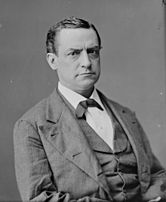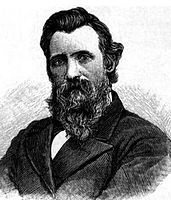United States House of Representatives elections, 1880
|
|
|||||||||||||||||||||||||||||||||
|---|---|---|---|---|---|---|---|---|---|---|---|---|---|---|---|---|---|---|---|---|---|---|---|---|---|---|---|---|---|---|---|---|---|
|
|||||||||||||||||||||||||||||||||
|
All 293 seats in the U.S. House of Representatives 147 seats were needed for a majority |
|||||||||||||||||||||||||||||||||
|
|||||||||||||||||||||||||||||||||
|
|||||||||||||||||||||||||||||||||
Joseph Keifer
Republican Party (United States)
Elections to the United States House of Representatives were held in 1880 for Representatives to the 47th Congress, coinciding with the election of President James A. Garfield.
Garfield's Republican Party managed to gain an outright majority of seats from the opposition Democratic Party. The Democratic loss of control in the House is historically seen as somewhat surprising, since no major issue played a role in their defeat. The end of Reconstruction and the pro-business nature of the Republicans were both minor factors. The ability of the Republican Party to paint several key Democratic leaders as corrupt also helped to alter the composition of the part just enough so that the Republicans gained a majority. The Greenback Party, which promoted the use of the paper currency and was seen as a pro-farmer party, also lost several seats due to national economic recovery, which aided the Republicans.
In 1845, Congress passed a law providing for a uniform nationwide date for choosing Presidential electors. This law did not affect election dates for Congress, which remained within the jurisdiction of State governments, but over time, the States moved their Congressional elections to this date as well.
In 1880, no states held their elections after Election Day for the first time (California was the last state to hold late elections, in 1878). But 5 states, with 35 seats among them, held their elections before the rest of the states:
...
Wikipedia




